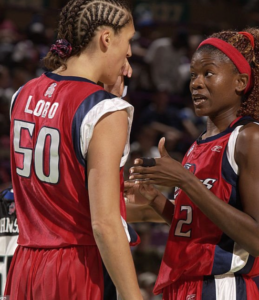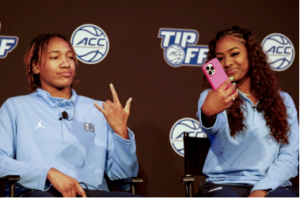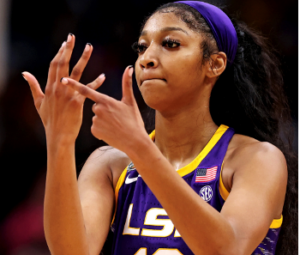By Shelby Swanson
While her teammates are dressed in practice pinnies and baggy hoodies, UNC junior guard Deja Kelly dons a skin-tight Carolina blue shirt as she laces up for a shootaround at the NCAA Tournament. Her hair is slicked back and her edges are laid in her signature “D-I do.”
She’s rocking pink acrylic nails and eyelash extensions. While she isn’t wearing any foundation or concealer — she’s not a big fan of heavy makeup during games — her eyebrows are plucked to perfection, and the gloss on her lips catches the fluorescent overhead lights.
Cultivating a “girly” image doesn’t stop the ACC first-team honoree from being a stone-cold killer on the court. The hair, nails, lashes and top-tier midrange game — it’s all part of the Deja Kelly package.
She’s not alone in today’s world of women’s hoops. The ability for players to craft a signature look is increasingly important, both culturally and economically.

“This generation, they’re very used to self-expression,” sports historian Susan Shackelford said. “Some of the top players, they will not play for a coach unless they can be themselves. It’s that important to them. They’re not going to give up all that.”
This hasn’t always been the case. Until recently, the stylistic choices that players like Kelly prize were left up to coaches and managers.
“I think we’ve seen the growth and expansion of (self-expression),” Kelly said. “People are more like, ‘OK, if I can express myself and showcase what I want to show on the court, I can be an example for the next generation.’”
‘Treading a fine line’
When women play sports, it creates tension.
The history of female athletics — as shown by the All-American Girls Professional Baseball League in the 1940s and 1950s — didn’t just put pressure on players to adhere to traditional femininity. It was required. In the AAGPBL rulebook, boyish bobs were outlawed and lipstick was mandated.
Fast-forward 40-odd years. It’s 1996. The WNBA is in its infancy and, as the league’s first president Val Ackerman told The Athletic, “Television was the driver.”
Arizona State University sports historian Victoria Jackson said the league was catering to the male gaze.
“If you look at the packages put out by the WNBA when the league launched, it’s just so cringey, looking at how they thought they should be promoting a women’s professional sports league,” Jackson said.

The WNBA’s “We Got Next” campaign is a perfect example. A video launching the initiative features Rebecca Lobo and Sheryl Swoopes exchanging seductive stares. They wear bold lipstick and strut alongside Lisa Leslie, who is styled in a crop top.
Per Jackson, women’s basketball has historically regulated player self-expression. WNBA owners worried that if their players looked too masculine, sponsors would tune out and viewers wouldn’t tune in.
Pamela Grundy, a women’s basketball historian and co-author of “Shattering the Glass,” said public opinion often saw contact sports as antithetical to femininity.
“When women have stopped to play sports in a serious fashion — you know, competitive,” she said, “they maybe bump into each other every now and then and their hair loses their shape. They’re treading a fine line.”
‘There’s more than one way to look sexy’
As UNC coach Courtney Banghart answered questions following North Carolina’s first-round win in the 2023 NCAA Tournament, she placed her hands on the shoulders of Kelly and junior wing Kennedy Todd-Williams.
“They’re different,” she said. “They have their own little — look at these two — they have their own little things. But there’s an enormous amount of respect they have for one another.”
The glammed-up Kelly juxtaposed with the plainly-dressed Todd-Williams is a microcosm of a larger cultural shift in the game.

“One day you can dress androgynously and the next day you can fem it up,” Jackson said. “In part, it’s because we see more of a diversity of expressions in media. A lot of the things we consume have a broader range of people and characters in them.”
Today’s players were raised on social media, in full control of their own appearance. They’ve watched athletes like Colin Kaepernick take a knee. They’ve witnessed player associations organize protests in the WNBA and NBA.
Not only do players feel safer being themselves on the court, but they know they hold the power to demand it.
When Sports Illustrated released its 2022 swimsuit edition featuring WNBA players in bikinis, Chicago Sky guard Courtney Williams took to Twitter to demand a more inclusive approach to style.
“It would have been raw to see a sleek lil sports bra & some shorts swaggin,” Williams wrote. “There’s more than one way to look sexy, and I hope in the future we can tap into that.”
Self-expression or self-consciousness?
Despite the progress made in women’s basketball and American culture, there is still pressure for athletes to conform to gender norms.
Kelly said she feels more eyes on her in the wake of rule changes that allowed college athletes to profit from the use of their name, image and likeness. Granted, that comes with benefits. After her Sweet 16 appearance in the 2022 NCAA Tournament, Naomi Osaka’s skincare brand KINLO reached out to partner with Kelly.
Connecticut Suns guard Nia Clouden doesn’t consider herself as girly as Kelly. She’s more of a sweatsuit person. But, if she was in college today, she said she would feel the need to glam up.
Aside from the pressure that NIL puts on women in college sports to constantly appear marketable, the stress to conform to gender norms extends further than that. Because sports and physicality are considered manly, Jackson said many of today’s players may play up their femininity to counteract their muscles.
However, to players like Clouden and Kelly, what they’re doing isn’t compensation — it’s authentic. And now brands are latching on to that swag.

Angel Reese, an All-American and 2023 national champion, is unabashedly herself — a self-described product of the Baltimore streets who trash-talks and plays with serious confidence. The ‘Bayou Barbie’ even keeps an extra pair of false eyelashes in the locker room in case she needs a mid-game touch-up.
By cultivating her appearance and attitude, Reese has more NIL deals than any other collegiate basketball player, male or female.
According to SponsorUnited’s 2022-2023 NIL marketing partnerships report, deals for female college hoopers have grown the most out of any group of athletes, even high-revenue sports like men’s basketball and football.
Maybe some players are curating their appearance due to internalized sexism or pressure from the market. Maybe they’re truly embracing self-expression.
Or maybe it doesn’t matter either way.
Regardless of their intent, the power is now in the hands of the players — the performers — to perfect their own persona.
Edited by Preston Fore, Allie Kelly and Guillermo Molero.